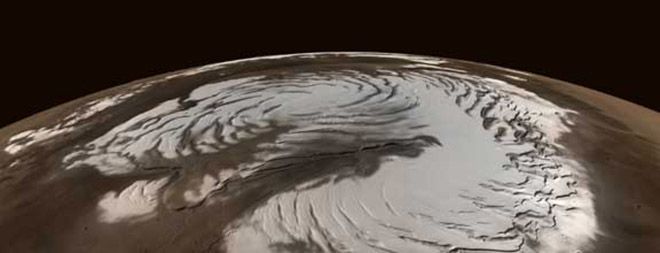Meteorites Help Reveal How Mars Lost Its Water

(ISNS) -- Mars was once a wetter world, and according to a growing body of evidence, could have had water gushing through rivers, pooling in lakes and possibly even oceans. But the water somehow vanished, leaving behind the parched planet it is today.
Now, a new analysis of Martian meteorites is helping to reveal the history of Martian water, suggesting that large amounts of water escaped into space within the first half-billion years of Mars' existence. Most of the remaining water -- as much as one tenth of the Earth's oceans -- then froze, forming vast, yet-to-be-discovered reservoirs of ice still hidden below the surface.
Scientists have long known that there's water ice at the poles and previous observations have hinted at the presence of subsurface ice at lower latitudes. The new study now strengthens the case that huge amounts of ice remain hidden on Mars today, said study-leader Hiroyuki Kurokawa of Nagoya University in Japan. The paper describing the results has been accepted for publication in Earth and Planetary Science Letters.
Orbiting spacecraft, landers and rovers on Mars have discovered plenty of evidence for valleys, deltas, riverbeds and even oceans once filled with liquid water — perhaps providing a habitable environment for life in the past. But most of the water has since vanished.
"We don't know how the water was disappearing over time," said David Klassen, an astronomer at Rowan University, in Glassboro, N.J., who wasn't involved in the study. "We just know it disappeared."
Still, scientists think most of the water on Mars probably escaped because the planet's gravity was not sufficient to hold onto its atmosphere. Over time, the water on Mars evaporated and drifted away into space.
To estimate how much water was lost this way, the researchers measured the ratio of two forms of hydrogen found in Martian meteorites that landed on Earth. Ordinary, common hydrogen contains one proton in its nucleus. Deuterium is a heavier form of hydrogen, with one proton and one neutron. Water that includes at least one deuterium atom instead of regular hydrogen is heavier.
Sign up for the Live Science daily newsletter now
Get the world’s most fascinating discoveries delivered straight to your inbox.
With this added heft, water that contains deuterium can't escape Mars' gravity as easily as water made of regular hydrogen. As a result, most of the water that left Mars is of the lighter variety. So by comparing the amounts of deuterium and hydrogen, the researchers can determine how readily water was escaping Mars. A higher deuterium-to-hydrogen ratio means greater water loss.
The researchers analyzed three different meteorites to determine the deuterium-to-hydrogen ratios from 4.5 billion years ago, 4.1 billion years ago, and sometime between 170 million and 180 million years ago, which is recent enough to represent current conditions. From the data, they created a timeline of water loss, showing that Mars may have lost several times more water between 4.5 billion and 4.1 billion years ago than the past 4 billion years.
Whether Mars lost its water earlier or later in its history has been a point of debate among astronomers, and determining the timing could help them pinpoint exactly how it left the atmosphere, said James Greenwood of Wesleyan University, in Middletown, Conn., who also wasn't a part of the study.
Some scientists have suggested that the solar wind helped strip away water from the Martian atmosphere. But, Greenwood explained, this would be a long-term process. An early burst of water loss could instead point to what's called hydrodynamic escape, in which the massive amounts of hydrogen gas that surrounded an embryonic Mars broke free from the planet's weak gravitational grip, dragging water along with it.
Meteorite data only reveal relative changes in water, so to determine how much water was lost, the team looked at estimates of past water based on previous observations of Martian surface features. The researchers realized that in order for their calculated timeline to be consistent with those estimates, there must be a lot of water still on Mars today — several times more than the water frozen at the poles.
The water, Kurokawa said, must be in the form of ice hidden below the surface—consistent with previous observations. For example, the Phoenix lander and the Mars Odyssey orbiter have found indirect hints of substantial subsurface ice.
Other scientists have also used meteorites to determine the water history of Mars, Greenwood said. But the new work incorporates a meteorite sample that originated from Mars' mantle, which enabled the researchers to reliably estimate water loss from 4.5 billion years ago for the first time. "I think it's an important contribution," he said.
This story was provided by Inside Science News Service. Marcus Woo is a freelance science writer based in the San Francisco Bay Area who has written for National Geographic News, New Scientist, and other outlets.












